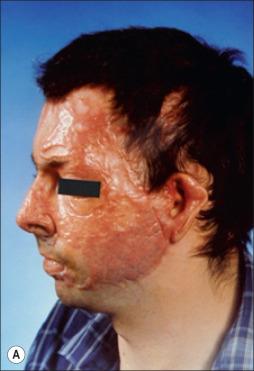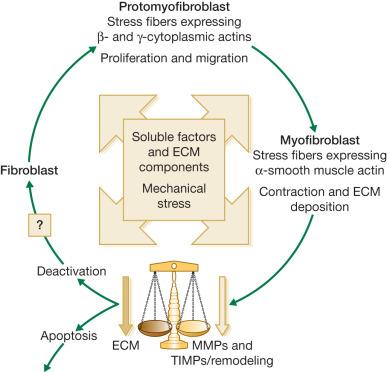Physical Address
304 North Cardinal St.
Dorchester Center, MA 02124
Clinically postburn hypertrophic scars (HTS) are elevated, erythematous, pruritic, and inelastic. In addition to poor cosmesis, these scars typically form contractures resulting in dysfunction and discomfort, leading to significant morbidity for burn patients ( Fig. 45.1 ). HTS is fundamentally different from normal skin and mature scar in several key ways: (1) the extracellular matrix (ECM) of HTS is significantly altered in both composition and architecture, (2) the behavior of keratinocytes and fibroblasts present in HTS is profibrotic compared to mature scar, and (3) many profibrotic cytokines are upregulated and their expression prolonged. Generally, HTS undergoes some remodeling and maturation over time, and this may account for the variability in descriptions of HTS. Many features of HTS are shared by other fibroproliferative disorders, including renal fibrosis, pulmonary fibrosis, and scleroderma. Thus understanding the pathophysiology of HTS applies to other areas of medicine, and developments in treating various fibroproliferative diseases can directly affect scar management. Since an exhaustive discussion of every nuance of abnormal wound healing is impossible, we focus on aspects of HTS formation highlighting well understood pathways or novel developments. It is our hope that a deeper understanding of abnormal wound healing pathophysiology and fibrosis will lead to nonsurgical treatments that improve life not only for burn patients, but for the many patients suffering fibrotic diseases.

ECM in healing wounds is laid down by fibroblasts and subsequently remodeled as the scar matures. The ECM in HTS displays significant differences from mature scar and normal skin, most notably in the arrangement and composition of collagen bundles and in the relative proportions of several proteoglycans. Owing to the interaction of fibroblasts and ECM, these differences not only result from abnormal fibroblast behavior but also contribute to it.
Collagen is the major constituent of ECM, providing a scaffold for cells and mechanical strength to tissues. In HTS the quantity of collagen per unit surface area is increased; however the relative proportion of collagen in HTS is decreased compared to normal skin, owing to much greater increases in proteoglycans and glycoproteins. In normal skin the majority of collagen is type I (80%) with smaller amounts of type III (10–15%) and type V (minimal), resulting in thick, regular collagen fibril bundles running parallel to the skin surface. In contrast, HTS is composed of greatly increased amounts of type III (33%) and type V (10%) collagen, which drastically alters collagen fibrils, making them thinner and disorganized. In normal wound healing, type III collagen appears early then gradually disappears as the scar is remodeled and matures, but this does not occur in HTS, where persistently high levels reflect biological immaturity.
Classic histologic descriptions of HTS highlight “whorls” and “nodules” of poorly organized collagen encapsulated in more normal-appearing collagen fibrils, as seen in Fig. 45.6 . However not only are collagen fibril composition and morphology altered in HTS, but interfibrillar spacing is also irregular and greatly increased. This space is filled with proteoglycans and glycoproteins whose composition is markedly different from normal skin and mature scar.
Proteoglycans are responsible for physical properties of skin such as turgor, resilience, and resistance to compression, resulting from their interaction with collagen. Proteoglycans also modulate the activities of multiple growth factors and cytokines. Glycoproteins, such as fibronectin, are generally involved in cell–matrix adhesion and influence cell behavior via this mechanism. Together proteoglycans and glycoproteins are major constituents of skin, both physically and functionally.
Proteoglycans are formed by a protein core, often with repeating units such as leucine in decorin, and glycosaminoglycan side chains. These side chains are ionized and hydrophilic and thus mainly responsible for tissue water retention. Early studies of HTS demonstrated elevated glycosaminoglycan levels, which are responsible for the hyperhydrated state of HTS that leads to its classically increased turgor. These levels of glycosaminoglycan are not uniformly elevated. Instead certain proteoglycans are downregulated and others upregulated, with unique implications for HTS.
Decorin is a prototypical small, leucine-rich proteoglycan (SLRP) produced in abundance in normal skin and mature scar but reduced by 75% in HTS. Originally named for “decorating” collagen fibrils, decorin affects wound healing via several distinct and complementary pathways. Decorin binds to collagen fibrils, controlling their diameter, morphology, and interfibrillar distance. In decorin knockout mice collagen fibrils are irregular in morphology and have highly variable diameters. Decorin binds to and inactivates the profibrotic cytokines transforming growth factor-β (TGF-β) and platelet-derived growth factor (PDGF). The effects of this inactivation are most readily visible in fibroblast-populated collagen lattices where decorin significantly reduces contraction by normal and HTS fibroblasts. Decorin also binds to and antagonistically downregulates several cell surface receptor tyrosine kinases: epidermal growth factor receptor (EGFR), hepatocyte growth factor receptor (HGFR), and insulin-like growth factor 1 receptor (IGF1R), which reduces cellular proliferation and migration. Decorin production increases significantly as scars mature. In a mouse model of diabetes, renal fibrosis and nephropathy developed significantly faster in decorin knockout than in wild-type mice. Similarly upregulating decorin production via an adenoviral vector in mouse models of bleomycin-induced pulmonary fibrosis reduced fibrosis.
In contrast to decorin downregulation, two other proteoglycans, biglycan and versican, are significantly upregulated in HTS. Biglycan is 57% similar to decorin in amino acid sequence but with two dermatan sulfate chains and is believed to have originated as a gene duplication of decorin. Despite these similarities, biglycan and decorin have significantly different functions in vivo. Biglycan is minimally present in normal skin but significantly up-regulated in fibrosis, yet it does not compensate for the lack of decorin. Versican is also significantly upregulated in HTS, up to six times higher than in normal skin, where it is normally confined to the proliferating epidermis. As a large proteoglycan with 12–30 glycosaminoglycans chains, versican is most likely responsible for the increased hydration and turgor leading to the increased volume of HTS.
The most common glycoprotein in ECM is fibronectin, which has effects on cell–matrix interaction via its interaction with integrins. Although the role of fibronectin in HTS is unclear, its upregulation in HTS, influence on the assembly of other ECM proteins, and interaction with cellular integrins suggest that it, too, plays a role in fibroblast behavior and HTS formation.
Fibroblasts are the cells primarily responsible for ECM production and remodeling in wound healing. Numerous studies have demonstrated that dermal fibroblasts can be divided into distinct subpopulations—superficial (papillary) and deep (reticular)—based on both physical location and phenotype. When characteristics of superficial dermal, deep dermal, and HTS fibroblasts are compared, as in Table 45.1 , it becomes clear that HTS fibroblasts most closely resemble deep dermal fibroblasts. These in vitro results correlate directly with a clinically relevant dermal scratch model developed by Dunkin and colleagues. In this model a linear skin wound is created with depth that increases along its length from no injury to full-thickness penetration. This results in regeneration in the superficial portion (depth ≤0.56 mm) with minimal scar; whereas HTS formation occurs in the deeper portion of the wound. Combining these basic science and clinical observations with the tendency of HTS to form following deep partial- to full-thickness burns suggests two possible theories of HTS formation: (1) selective proliferation of deep dermal fibroblasts after fibrogenic cytokine stimulation, or (2) destruction of superficial dermal fibroblasts by thermal injury, leaving only deep dermal fibroblasts to repopulate the wound. Both theories are consistent with an experimental model in which human skin was grafted onto the backs of nude mice and subsequently injured. In this model, deep dermal fibroblasts closed wounds and superficial dermal fibroblasts then remodeled them. It is possible that in deep burns superficial fibroblasts are not present to initiate this remodeling process, leaving the healing wound in a hyperactive state ( Fig. 45.2 ).
| Superficial Dermal Fibroblasts | Deep Dermal Fibroblasts | Hypertrophic Scar Fibroblasts | |
|---|---|---|---|
| Collagen production | ↓ | ↑ | ↑ |
| Collagenase production | ↑ | ↓ | ↓ |
| Decorin production | ↑ | ↓ | ↓ |
| TGF-β production | ↓ | ↑ | ↑ |
| CTGF production | ↓ | ↑ | ↑ |
| Keratinocyte proliferation | ↑ | ↓ | ↓ |
| Capillary formation | ↑ | ↓ | ↓ |

Myofibroblasts are cells that have acquired a phenotype intermediate between fibroblasts and smooth muscle cells. Presently it is accepted that myofibroblast modulation of fibroblastic cells begins with the appearance of precursor proto-myofibroblasts whose stress fibers contain only β- and γ-cytoplasmic actins. These proto-myofibroblasts acquire de novo contractile bundles whose stress fibers generate sufficient forces to pull cells forward to populate tissue spaces in a migration process and to pre-remodel the ECM. Proto-myofibroblasts evolve, but not necessarily always, into the differentiated myofibroblast. Fully differentiated myofibroblasts express α-smooth muscle actin (α-SMA), the actin isoform present in typical contractile vascular smooth muscle cells ( Fig. 45.3 ). The presence of α-SMA is directly related to the contractile activity of myofibroblasts. A direct correlation has been demonstrated both in vitro and in vivo between the level of α-SMA expression and myofibroblast contraction. Myofibroblasts also exhibit some similarities with pericytes. In physiological conditions, after healing, myofibroblasts undergo apoptosis, and only a few fibroblasts are left to ensure renewal of the ECM.

Among the soluble factors, TGF-β1 is a potent inducer of myofibroblast differentiation. TGF-β1 action on myofibroblast differentiation is only possible in the presence of ED-A fibronectin, which underlines the fact that ECM components play an important role in soluble factor activity. Granulocyte–macrophage colony-stimulating factor stimulates macrophage proliferation and myofibroblast differentiation, thereby promoting granulation tissue formation. Endothelin has also a positive effect on differentiation and activation of myofibroblasts. This peptide also induces myofibroblast contraction and migration. More recently it has been shown that granulation tissue formation is modified by chemical denervation. This peripheral nervous system involvement in tissue repair has likewise been shown in the liver; in this organ, in an experimental model of fibrosis using carbon tetrachloride treatment, chemical denervation significantly reduces matrix deposition and myofibroblast differentiation.
Become a Clinical Tree membership for Full access and enjoy Unlimited articles
If you are a member. Log in here